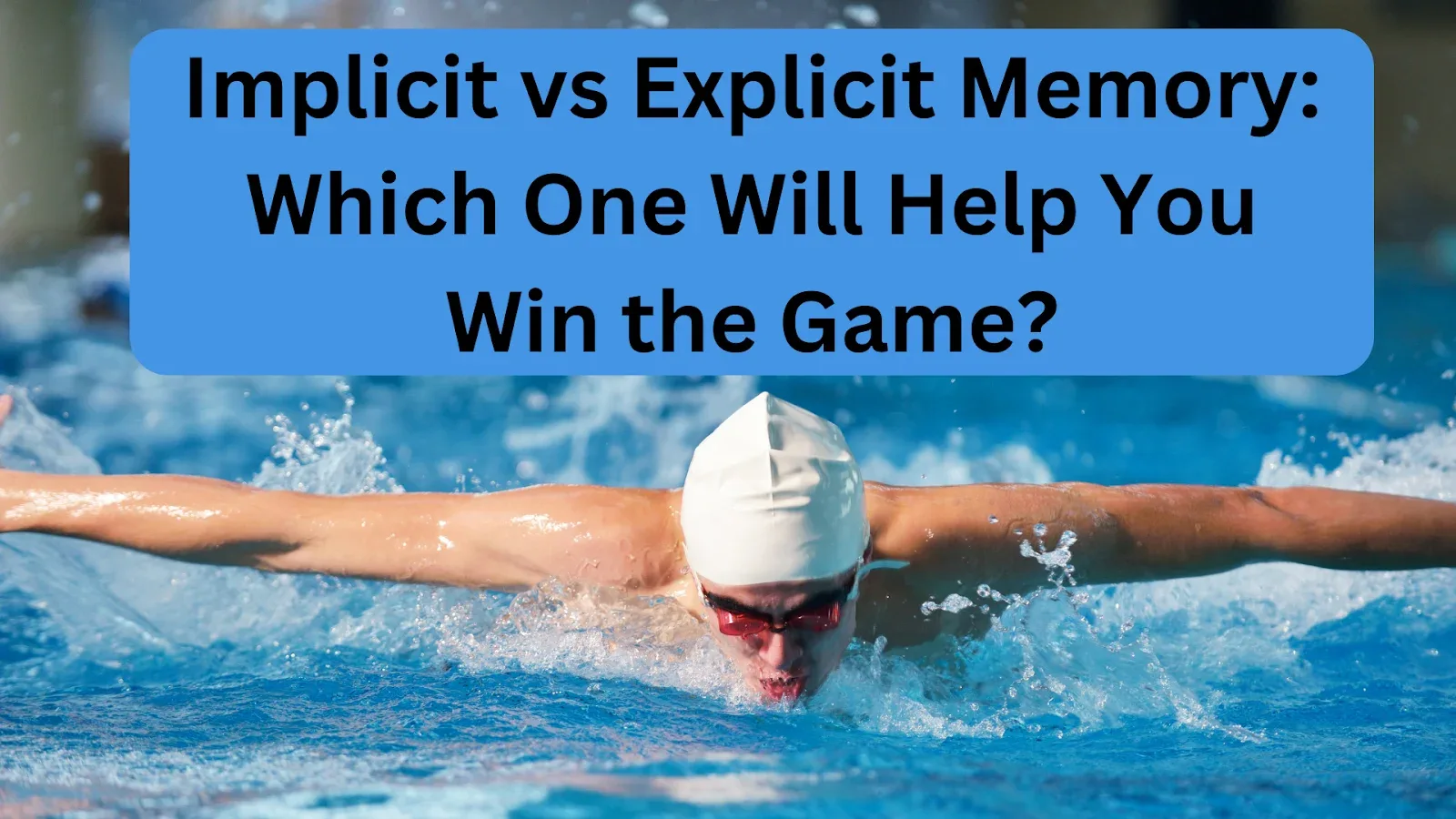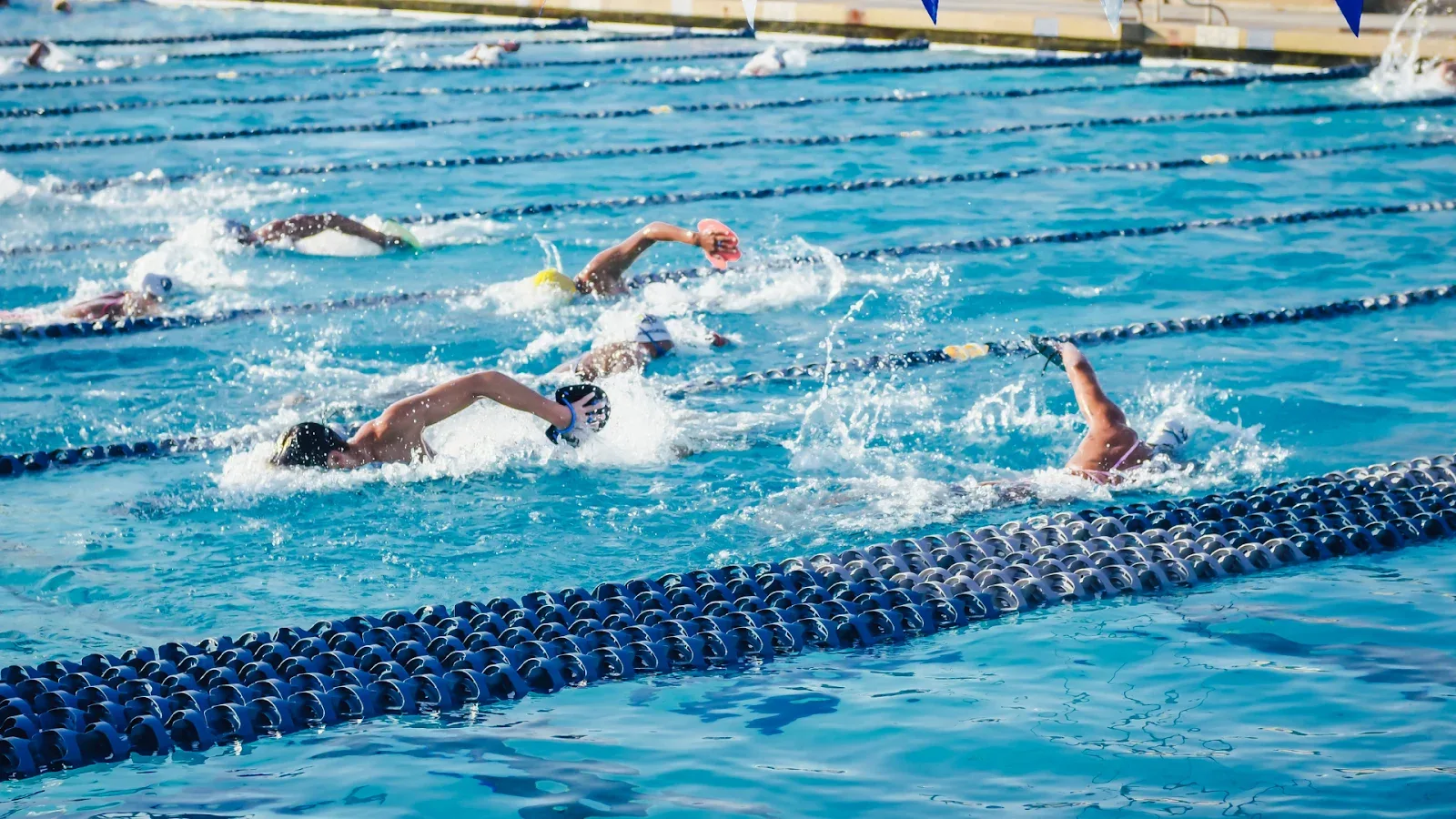
So today, we’re diving into implicit vs explicit memory and figuring out which one will help you win the game.
Ever wondered why some athletes seem to perform flawlessly without thinking?
It’s like they’re on autopilot, nailing every move effortlessly.
That’s the magic of memory at work!
In sports, how you remember things can make or break your performance.
What is Implicit Memory?
Implicit memory is like your brain’s autopilot mode.
You don’t have to think about it. It just happens.
Remember the first time you rode a bike?
It took a lot of effort, but now you can do it without a second thought.
That’s implicit memory in action!
It’s all about those automatic skills and habits that come from repetition.
Let’s break it down a bit more.
Implicit memory is part of your long-term memory that doesn’t require conscious thought.
It’s procedural, meaning it helps you perform tasks without actively trying to remember how to do them. T
his type of memory is super powerful in sports because it allows athletes to perform complex movements smoothly and efficiently.
Imagine a soccer player weaving through defenders with the ball at their feet.
They aren’t consciously thinking about every step and touch. They’ve practiced so much that their movements are automatic.
That’s implicit memory at work.
It allows for fluid, split-second decisions that are crucial in fast-paced sports.
Another great example is a pianist playing a piece of music.
After years of practice, their fingers move across the keys effortlessly, without them having to read every note or think about each finger placement.
This is the essence of implicit memory: skills become so ingrained that they flow naturally.
In the world of sports, implicit memory is built through repetition and practice.
Drills, exercises, and game simulations are designed to reinforce these automatic responses.
When athletes practice their skills over and over, they are training their implicit memory, making their movements more natural and instinctive during actual games.
Think about it like this: when you first learn a new sport, you have to concentrate hard on each move.
But as you practice, those moves become second nature.
Your body knows what to do without you having to think about it.
This is why consistent practice is so important. It transforms your conscious efforts into automatic responses, thanks to implicit memory.
So, implicit memory isn’t just about remembering how to ride a bike or tie your shoes.
It’s about creating a mental and physical foundation that lets you perform at your best without overthinking.
In sports, this can be the difference between hesitating and seizing the moment to make a game-winning play.
What is Explicit Memory?
Now, let’s talk about explicit memory.
This is the stuff you have to think about.
Like remembering your friend’s birthday or that tricky math formula.
Explicit memory is all about conscious thought and deliberate recall.
In sports, it’s remembering the playbook, the rules, and the strategies you need to outsmart your opponent.
Explicit memory, also known as declarative memory, is divided into two types: episodic and semantic.
Episodic memory refers to your ability to recall personal experiences and specific events, such as the first time you scored a goal in a match or the details of a significant game.
Semantic memory, on the other hand, involves general knowledge and facts, like understanding the rules of basketball or knowing the techniques of a perfect swim stroke.
Think about a tennis player who needs to remember the specific serve techniques taught by their coach.
This involves explicit memory because the player must consciously recall the steps and strategies for each serve.
Similarly, a football player memorizing different plays in the playbook is using explicit memory to remember and execute these plays during a game.
Explicit memory is crucial for learning and improving performance.
When you’re studying game footage, analyzing opponents’ tactics, or learning new skills, you’re relying on explicit memory.
This type of memory helps you understand and internalize complex information that you can apply during practice and games.
In training, explicit memory comes into play when you’re trying to master a new technique or understand a new strategy.
For example, a gymnast learning a new routine will need to remember the sequence of movements and the specific techniques required for each part of the routine.
By consciously practicing and recalling these details, the gymnast can improve their performance and execute the routine with precision.
Moreover, explicit memory is essential for adapting and making strategic decisions during a game.
A basketball player might use explicit memory to remember the specific defense techniques they’ve studied or the offensive plays they’ve planned.
This allows them to make informed decisions in real-time, adapting their strategies based on the evolving dynamics of the game.
It’s also important for team coordination and communication.
When team members have a shared understanding of the playbook and strategies, they can work together more effectively.
This collective explicit memory ensures that everyone is on the same page and can execute plays seamlessly.
In summary, explicit memory is about conscious learning, understanding, and recall.
It’s the foundation for acquiring new knowledge, mastering complex skills, and making strategic decisions in sports.
While implicit memory helps you perform automatically, explicit memory gives you the knowledge and understanding needed to improve and excel.
Both types of memory are essential for athletes, but explicit memory is particularly important for learning, strategy, and adaptation in the ever-changing landscape of competitive sports.

How Do These Two Types of Memories Help Me with Training?
So, how do implicit and explicit memory help with training?
Let’s break it down.
Implicit memory helps you develop automatic responses and muscle memory.
Think about a tennis player’s perfect serve: it’s all muscle memory from hours of practice.
When you practice the same skill repeatedly, your body starts to remember the movements.
This makes your performance more efficient and fluid during actual games.
Implicit memory is all about making these movements second nature so that, under pressure, your body knows what to do without you having to think about it.
For example, let’s say you’re a basketball player working on your free throws.
Initially, you’ll focus on every aspect of your technique: how to hold the ball, the position of your feet, the angle of your shot.
Over time, with consistent practice, these actions become ingrained in your muscle memory.
During a game, you won’t need to think through each step; your body will just execute the perfect free throw automatically.
This is the power of implicit memory in action.
On the flip side, explicit memory is crucial for learning new strategies, techniques, and understanding the game’s nuances.
When you’re studying game footage, analyzing your opponent’s tactics, or memorizing new plays, you’re using explicit memory.
This conscious recall and application of information help you improve your understanding and performance in the sport.
Consider a football quarterback learning new offensive plays.
They need to memorize each play’s specific routes, the timing, and the role of each player.
This involves explicit memory because they have to consciously recall and execute these plays during practice and games.
The more they study and practice, the better they remember and execute these strategies under pressure.
Explicit memory also plays a vital role in understanding the rules and regulations of your sport.
Knowing the rules inside out helps you make quick decisions and avoid penalties during a game.
For instance, a soccer player needs to remember the offside rule and apply it during fast-paced matches to avoid costly mistakes.
This kind of knowledge, stored in explicit memory, is essential for effective gameplay.
Moreover, explicit memory helps you adapt and adjust your strategies based on real-time feedback.
During a game, you might need to remember a specific strategy you’ve learned and apply it to counteract your opponent’s tactics.
For example, a basketball player might recall a defensive play they’ve practiced to shut down a high-scoring opponent.
This ability to adapt and recall specific information is what makes explicit memory so crucial in sports.
In training, a combination of both implicit and explicit memory is necessary for comprehensive development.
While implicit memory helps you perform skills automatically and efficiently, explicit memory provides the knowledge and understanding needed to improve and refine those skills.
Balancing both types of memory ensures that you’re not only physically prepared but also mentally equipped to handle different game scenarios.
Using drills that incorporate both types of memory can be particularly effective.
For example, running through plays repeatedly helps build implicit memory, while discussing and analyzing those plays with your coach enhances explicit memory.
This holistic approach to training ensures that you’re developing a well-rounded skill set.
In summary, implicit and explicit memory both play crucial roles in training.
Implicit memory helps you develop automatic, efficient movements, making your performance smoother and more reliable under pressure.
Explicit memory helps you learn and remember strategies, techniques, and rules, enabling you to make informed decisions and adapt during games.
By integrating both types of memory into your training routine, you’ll be better equipped to excel in your sport.
Which One to Focus on When Training?
You might be wondering, “Which one should I focus on when training?”
The answer is both, but it depends on the situation and the phase of your training.
- Early Training Phases: Focus on Explicit Memory
When you’re just starting out or learning a new skill, explicit memory should be your main focus.
This phase is all about understanding the techniques, strategies, and rules of the game.
You need to consciously learn and remember the steps involved in performing a skill correctly.
For example, a beginner tennis player needs to learn the proper grip, stance, and swing techniques.
This requires a lot of conscious effort and deliberate practice, relying heavily on explicit memory.
To enhance explicit memory during this phase, you can:
- Study Manuals and Guides: Read up on techniques and strategies relevant to your sport.
- Watch Tutorial Videos: Visual learning can help you understand the finer details of skills.
- Break Down Skills: Focus on each component of a skill separately before putting them together.
- Use Mnemonics and Repetition: Create memory aids and repeat information to reinforce learning.
- Intermediate Training Phases: Balance Both Memories
As you progress and become more comfortable with the basics, it’s time to start balancing both implicit and explicit memory.
While you continue to refine your skills through deliberate practice (explicit memory), you should also start incorporating more automatic responses (implicit memory).
For instance, a soccer player who has learned the basics of dribbling, passing, and shooting should now practice these skills in game-like scenarios.
This helps transfer the learned skills from explicit to implicit memory, making them more automatic and natural.
- To balance both types of memory:
Practice in Game-Like Conditions: Simulate actual game scenarios to develop automatic responses.
Use Feedback Loops: Analyze your performance, make adjustments, and practice again.
Mix Up Training: Combine drills that enhance both implicit and explicit memory.
Incorporate Decision-Making: Practice drills that require quick thinking and decision-making.
Advanced Training Phases: Focus on Implicit Memory
When you reach a high level of proficiency, the focus shifts more towards implicit memory.
At this stage, you want your skills to be so ingrained that you can perform them without conscious thought, especially under pressure.
This is crucial for high-stakes situations where overthinking can hinder performance.
- For advanced athletes:
Intensive Repetition: Continue practicing key skills until they become second nature.
Pressure Drills: Train under conditions that mimic the stress and intensity of actual competition.
Refine Techniques: Make small adjustments to perfect your skills, but rely on your muscle memory for execution.
Mental Rehearsal: Visualize yourself performing flawlessly to reinforce automatic responses.
Situational Focus: Adjust Based on Needs
It’s also important to adjust your focus based on specific needs.
For instance, if you’re preparing for a big game, you might emphasize implicit memory to ensure smooth, automatic performance.
On the other hand, if you’re integrating a new strategy or play, you’ll need to focus more on explicit memory to learn and understand it thoroughly.
In summary, while both implicit and explicit memory are important throughout your training journey, the focus should shift based on your skill level and the specific demands of your sport.
Early training phases should emphasize explicit memory to build a strong foundation of knowledge and technique.
As you progress, balance both types of memory to refine your skills and make them more automatic.
In advanced stages, prioritize implicit memory to ensure seamless, high-level performance under pressure.
By strategically focusing on the right type of memory at the right time, you’ll maximize your training effectiveness and enhance your overall performance.

Examples on How to Use Implicit Memory
Here are some tips to boost your implicit memory during training:
1. Repetition, Repetition, Repetition
One of the most effective ways to enhance implicit memory is through repetition.
Practicing your skills over and over helps your brain and body memorize the movements until they become second nature.
Whether it’s shooting free throws in basketball, serving in tennis, or passing in soccer, the key is consistent, focused practice.
Example: A basketball player spends hours each day practicing their jump shot.
Over time, the mechanics of the shot become ingrained in their muscle memory, allowing them to execute it flawlessly during a game without thinking about each component of the motion.
2. Game-Like Conditions
Train under conditions that mimic actual game scenarios.
This helps develop automatic responses that are crucial during real competitions.
The more your training environment resembles a real game, the more effective your implicit memory will be.
Example: A football team practices with a running clock, crowd noise, and competitive drills to simulate the pressure and pace of a real game.
This prepares the players to perform automatically and effectively during actual matches.
3. Muscle Memory Drills
Focus on drills that enhance muscle memory.
These drills should be designed to reinforce the specific movements and skills you need in your sport.
Example: A swimmer practices their start dives repeatedly, focusing on the precise timing and technique needed to launch off the blocks quickly.
By repeating this drill, the swimmer’s body learns the exact motions required for a powerful start, making it automatic in races.
4. Small-Sided Games and Scrimmages
Participate in small-sided games and scrimmages.
These provide a controlled yet dynamic environment where you can practice skills and decision-making in a game-like context.
Example: Soccer players engage in 3v3 or 5v5 mini-games.
These smaller games increase the number of touches on the ball and decision-making opportunities, helping players develop quick, automatic responses to various game situations.
5. Visualization and Mental Rehearsal
Visualization can also strengthen implicit memory.
Mentally rehearsing your performance helps your brain encode the movements and actions, making them more automatic during actual play.
Example: A gymnast visualizes their entire routine, picturing each flip, twist, and landing.
This mental practice complements physical training, reinforcing the muscle memory needed for a flawless performance.
6. Routine and Consistency
Developing a consistent routine in your training can help reinforce implicit memory.
The more regular and predictable your training schedule, the easier it is for your body to learn and automate the necessary skills.
Example: A baseball pitcher follows a strict warm-up and pitching routine every day.
This consistency helps the pitcher’s body remember the exact mechanics of their pitches, making their delivery more reliable and automatic during games.
7. Feedback and Adjustment
Use immediate feedback to make slight adjustments during practice.
This helps fine-tune your movements and reinforces the correct techniques in your implicit memory.
Example: A golfer uses video analysis to review their swing in slow motion.
By making small adjustments based on this feedback and practicing the corrected swing repeatedly, the golfer enhances their muscle memory for a more accurate and consistent swing.
8. Conditioning Drills
Conditioning drills that mimic game situations help players react automatically to various scenarios, building implicit memory for real-game actions.
Example: A hockey player practices breakaway drills where they must quickly react and decide whether to shoot or deke the goalie.
These drills help the player develop automatic responses for real breakaway situations in games.
By incorporating these strategies into your training routine, you’ll be able to strengthen your implicit memory, making your movements and responses more automatic and efficient.
This not only enhances your performance during games but also boosts your confidence, allowing you to focus on strategy and decision-making rather than the mechanics of your actions.
Examples on How to Use Explicit Memory
To enhance your explicit memory, try these tips:
1. Study the Playbook
Spending time learning and memorizing the plays and strategies is crucial.
Familiarize yourself with the playbook, understand the roles and responsibilities, and know the sequences of actions.
Example: A football quarterback dedicates time each day to studying the team’s playbook.
By memorizing the specific routes and options for each play, the quarterback can make quick and informed decisions on the field.
2. Watch Game Footage
Analyzing past games helps you understand what works and what doesn’t.
Watching both your own performances and those of opponents can provide valuable insights.
Example: A basketball player reviews game footage to study the defensive strategies of upcoming opponents.
By understanding their patterns and tendencies, the player can anticipate and react more effectively during the game.
3. Mental Rehearsal
Visualize yourself performing the skills and strategies to reinforce explicit memory.
This mental practice can be just as effective as physical practice in some cases.
Example: A gymnast mentally rehearses their entire routine, step by step, before performing it.
This helps reinforce their memory of the sequence and techniques, leading to a more confident and precise performance.
4. Break Down Complex Skills
When learning a new skill, break it down into smaller, manageable parts.
Focus on mastering each part before putting them together.
Example: A golfer learning a new swing technique breaks it down into grip, stance, backswing, and follow-through.
By focusing on each component separately, they can better understand and perfect the overall technique.

5. Use Mnemonics and Repetition
Create memory aids to help you remember key information.
Repeating this information regularly helps reinforce it in your memory.
Example: A swimmer uses acronyms to remember the order of strokes in an individual medley (e.g., “Butterfly, Backstroke, Breaststroke, Freestyle” can be remembered as “B-B-B-F”).
Repeating this sequence regularly during practice ensures it’s ingrained in their memory.
6. Active Learning Techniques
Engage in active learning techniques such as discussing strategies with teammates, teaching others, or writing down your understanding of plays and techniques.
Example: A soccer coach encourages players to explain the team’s defensive strategies to each other.
Teaching and discussing these strategies helps players better understand and remember their roles on the field.
7. Structured Training Sessions
Organize your training sessions to focus on specific aspects of the game.
This helps in retaining and recalling detailed information about techniques and strategies.
Example: A tennis player follows a structured training program that dedicates specific days to working on serve technique, return strategies, and net play.
This focused approach helps the player remember and improve each aspect of their game.
8. Use Technology and Apps
Utilize sports apps and technology to track progress, review techniques, and stay updated with new strategies.
Example: A cyclist uses a training app to log workouts, analyze performance data, and set goals.
Reviewing this information regularly helps the cyclist remember and implement effective training techniques and strategies.
9. Interactive Drills and Simulations
Participate in drills and simulations that require you to recall and apply specific strategies and techniques.
Example: A volleyball team uses simulation drills where players must remember and execute specific plays under time constraints.
This helps reinforce their memory of the plays and improves their ability to perform them during actual games.
10. Regular Review Sessions
Schedule regular review sessions to revisit and reinforce important information.
This helps ensure that critical knowledge remains fresh in your memory.
Example: A rugby team holds weekly review sessions to go over the game plan, analyze past performances, and discuss upcoming strategies.
This continuous review helps players retain and recall important tactical information during matches.
By incorporating these strategies into your training routine, you’ll be able to strengthen your explicit memory, making it easier to learn, remember, and apply complex information and strategies in your sport.
This not only enhances your overall performance but also gives you a competitive edge by ensuring you’re always prepared and knowledgeable about the game.
Conclusion
In the battle of implicit vs explicit memory, both are winners.
They each play a crucial role in training and performance.
By balancing both types of memory, you’ll be well on your way to becoming a high-performing athlete.
And hey, if you’re looking for a way to really up your game, check out our Success Stories Membership.
You’ll get access to top-notch training that helps you master both implicit and explicit memory, plus a community of like-minded athletes who are all about achieving high performance.
Don’t miss out on the chance to take your skills to the next level!



